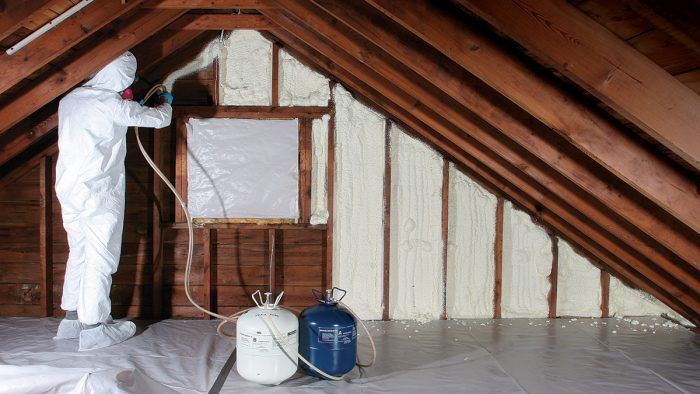Is There Environmentally Friendly Spray Foam Insulation?
HFO-blown foam is significantly better than HFC-blown foam when it comes to global warming potential, but no spray foam has zero environmental impact.

I’ve heard there is a more environmentally friendly type of closed-cell spray foam, but my insulation contractor isn’t sure what I mean. I’m told the product they spray has zero ozone-depleting potential—is that the type I should use?
—Rick Morrison via email
Green builder and designer Michael Maines replies: Spray-foam contractors tout that their product has “zero ozone-depleting potential.” All that means is that they are complying with a law that has been on the books for ten years. Much more relevant is the global warming potential, or GWP. Typically based on a 100-year scale, the GWP is a measure of how the embodied carbon in a product will affect our atmosphere in comparison to CO2, which is assigned a value of 1. CO2 is a prevalent greenhouse gas. When it or other greenhouse gases enter the atmosphere a few miles above the earth’s surface, they trap heat. Some break down relatively quickly; others last (and accumulate) nearly forever.
The blowing agents in the vast majority of closed-cell foam used today—HFC-245fa or similar—are potent greenhouse gasses with a GWP around 1000. A rule proposed by the EPA in 2015 would have phased them out by January 2020, but a federal appellate court in 2017 reversed the rule.
Manufacturers Honeywell and Chemours moved ahead developing blowing agents and adjusting their spray-foam recipes to work with the lower-GWP chemical hydrofluoroolifin, or HFO. HFO’s GWP is about the same as CO2. That’s not the whole story, though. A life-cycle analysis (LCA) commissioned by the spray-foam industry found that while reducing the impact of the blowing agent makes a big difference, the other raw materials—especially the polyols and the TCPP flame retardant—still create large emissions. In total, over a 100-year span, and assuming a 75-year service life in a building, R-21 HFO-blown foam is calculated to emit the equivalent of 3.08 lb. of CO2 for every square foot of wall area. If a new home has 1600 sq. ft. of wall area, it releases the equivalent of 5038 lb. of CO2. In comparison, driving a car releases about 20 lb. of CO2 per gallon of gasoline. So spray foaming your walls is like burning 254 gal. of gasoline, as much as you would use driving 6400 miles in an average new car. That’s for the “good” foam, with HFO as a blowing agent, and just for walls—spray-foaming a roof and basement may quadruple that value.
That is significantly better than conventional HFC-blown foam, which has an LCA CO2-equivalent emission 4.2 times greater than HFO-blown foam. But despite being 1000 times less harmful, new blow agents are still not “environmentally friendly.” Spray foam advertising doesn’t phrase it that way, skipping the overall effect and implying that having zero ozone depletion means there is no environmental impact.
That said, there are few downsides to using HFO-blown foam instead of HFC-blown foam aside from its relative newness, which results in many installers treating it as a special order or upgrade. Other installers charge the same or less than HFC-blown foam because HFO-blown foam is easier to install. Before going all in on HFO-blown foam for all of your insulation, consider a few things:
- Almost all other insulation types have lower embodied carbon emissions and fewer health risks to installers and occupants, and they are reversible—it’s almost impossible to remove spray foam during a remodel.
- Some insulation, such as cellulose and wood fiber, emit no net carbon, but actually sequester it—they have a negative GWP.
- Using a 100-year time scale to measure the impact of products is the convention, but it does not address the urgency of the climate-change problem. I think we should be looking at a 10- to 20-year scale, where spray foam of all types will look worse compared to other insulation because so much of its impact occurs at or before installation.
- Not every “R” is worth the same. The first R-10 does the most work. The next R-10 does half as much work, so the benefit of spray foam is greatest in the first inch or two of thickness. While there are situations such as unvented roofs or rubble foundation walls where no other material can do everything needed as well as closed-cell spray foam, that doesn’t mean you should use it everywhere. Using a flash-and-batt approach where a thin layer of foam is blown against the sheathing and the balance of the cavity is filled with other insulation (see “Why Flash and Batt Makes Sense,” FHB #217) minimizes the amount of high-carbon material needed. If you need the moisture resistance that foam provides, using the cut-and-cobble method with recycled foil-faced polyisocyanurate foam can also work.
Photo: Justin Fink
From Fine Homebuilding #297
Fine Homebuilding Recommended Products
Fine Homebuilding receives a commission for items purchased through links on this site, including Amazon Associates and other affiliate advertising programs.

Insulation Knife

Disposable Suit

Utility Knife



























View Comments
Thank you Michael for this article. It is surprisingly challenging to find accurate and comprehensive analysis of this. Given the number of sprayfoam businesses in BC who claim to have no environmental impact, providing sprayfoam installers with a working knowledge of these facts seems imperative if we expect to meet our 2030 emissions IPCC reductions targets "The building sector also requires profound changes. Reducing greenhouse gases 50% can be delivered through greater efficiencies in use of building space alongside energy efficient refurbishment and net zero-emission construction." https://earth.stanford.edu/news/roadmap-reducing-greenhouse-gas-emissions-50-percent-2030#gs.2xxev3